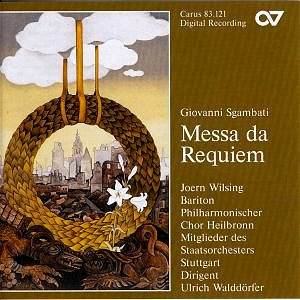An Italian grand requiem written around the axle of
the 19th and 20th centuries might almost be predictable. It will be
operatic. It will doff the hat to Verdi. It will have its vulgar moments.
It will be recorded by an Italian orchestra on an Italian label like
Dynamic, Bongiovanni, Aura or Nuova Era. Wrong, in this case, on most
counts.
Sgambati was born in Rome, the son of a lawyer and
his English wife. Liszt discovered the musically gifted Sgambati but
later Wagner also took up his case. There is a piano concerto (1878-80),
two overtures and two symphonies of which the first is from 1880. There
is also a selection of chamber works including two piano quintets and
string quartet. There were no operatic escapades - unusual for an Italian
composer of that era.
The Mass is believed to have been written on the death
of Vittorio Emmanuele II in 1895 then revised on the death of King Umberto
I in 1901. Schotts published the work in 1906, 1908.
Quiet non-belligerent waves of sound surge and roll
with the suave smoothness of plainchant. Latinate melodrama is a scarce
commodity here. The work's determinedly modest approach reminded me
of Josef Foerster's Missa Glagolytica. The colour wheel used
by Sgambati is one of pastels - a requiem in aquatints with Elysian
overtones as in track 3 where the effect is as if Finzi's Introit
had met Fauré's Requiem. Indeed there is a prominent
role for a solo violin in Olympian tones which refer back to the Beethoven
violin concerto in both the Offertorio and the Agnus Dei (tr.6).
There is, of course, drama as well; we hear this in
the Dies Irae (tr.2) where the music seems to stream flames.
The Dies Irae is quoted. At this point and in the finale the
work echoes, in 19th century weeds, Franz Schmidt's work of the 1930s,
The Book of the Seven Seals. It is as if one of Dürer's
apocalyptic engravings had sprung to life with the horsemen abroad in
the land. In the thudding punched out Osanna in excelsis of the
Sanctus (tr.4) we hear more of that dramatic element. It surfaces
again in the Libera me (tr.7) where, after the sunless sea of
the opening pages, there are blurting fruity trombones and a grunting
tuba. The choral writing with its swingingly positive tone at this point
calls up memories of Paul Paray's St Joan Mass. Apart from the
baritone's insistence on singing lux perpitua rather than the
correct lux perpetua his role is carried off with rasp and sonority.
This Choir give an annual concert in the church of
St Kilian, Heilbronn to remember the destruction of Heilbronn on 4 December
1944. The Sgambati is in the choir's tradition having been sung by them
in 1956 and 1959 conducted by Dr Ernst Mueller. The present recording
was made after the success of their revival of the work in 1988.
This is commendable revival. A requiem in which the
Fauré-like reticence of plainchant meets the drama of apocalyptic
visions.
Rob Barnett
